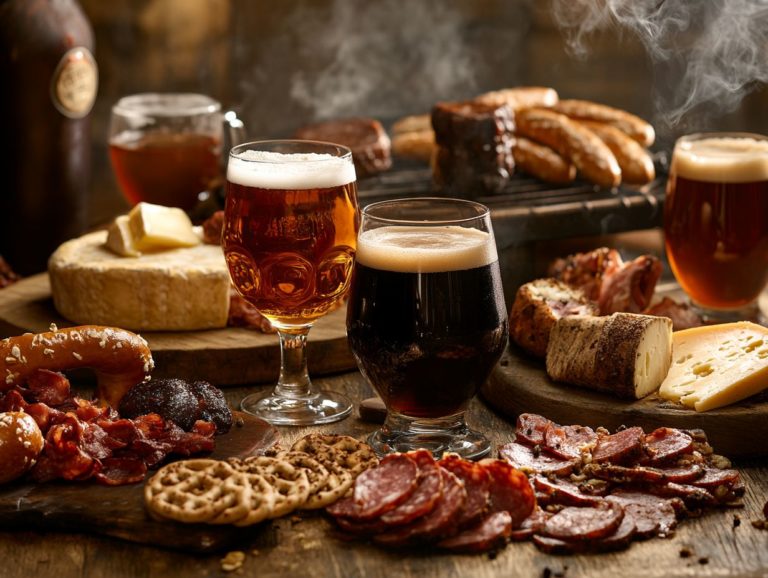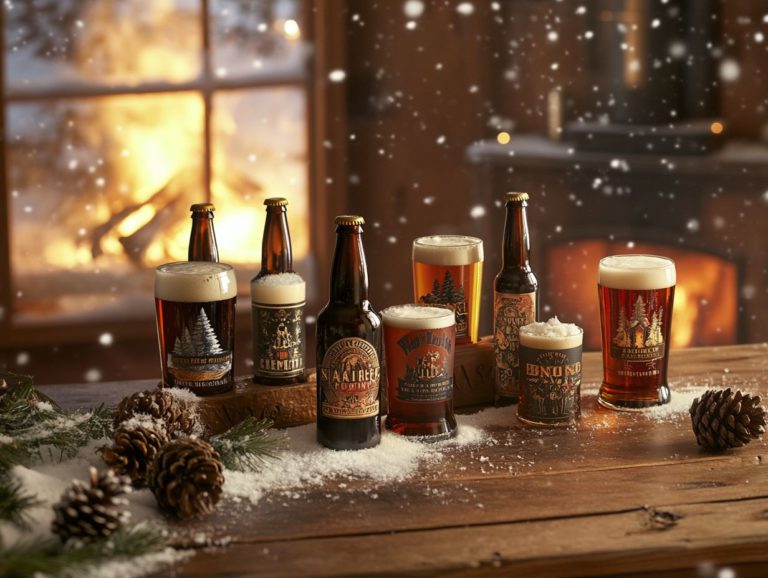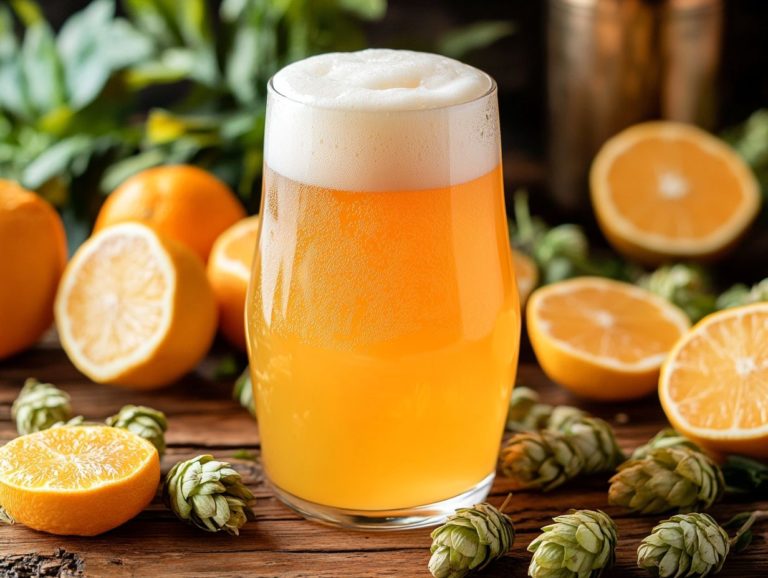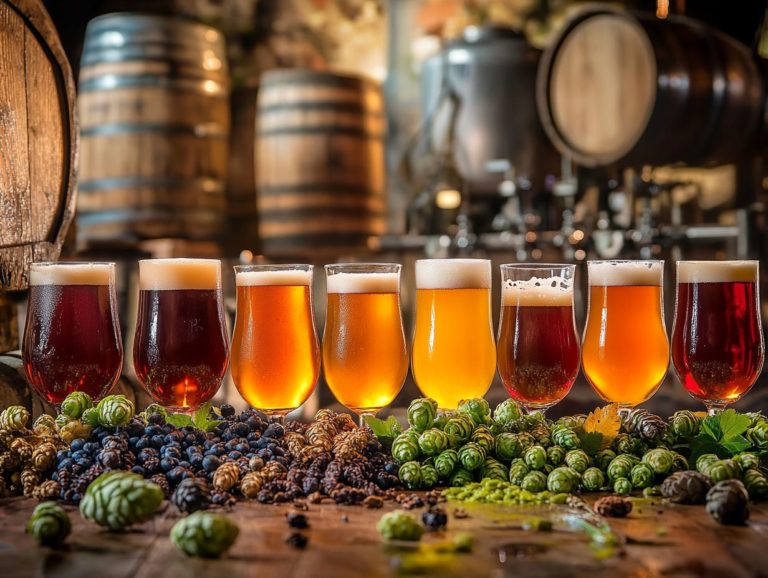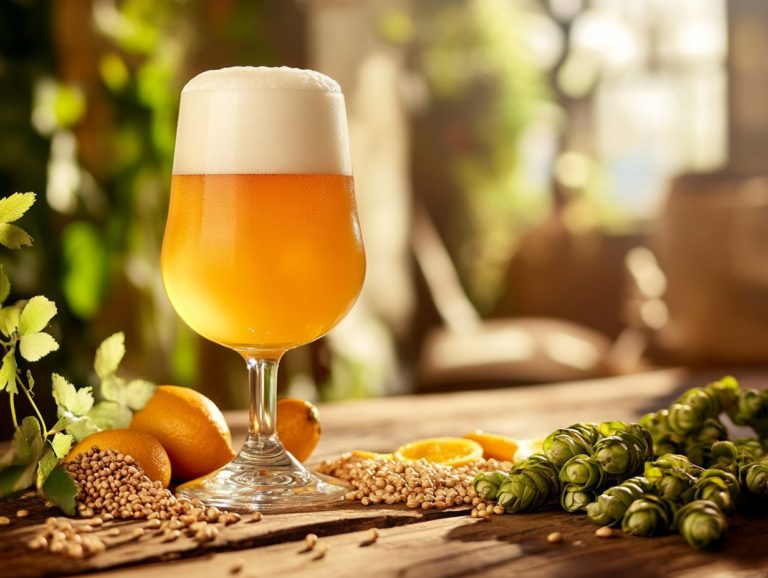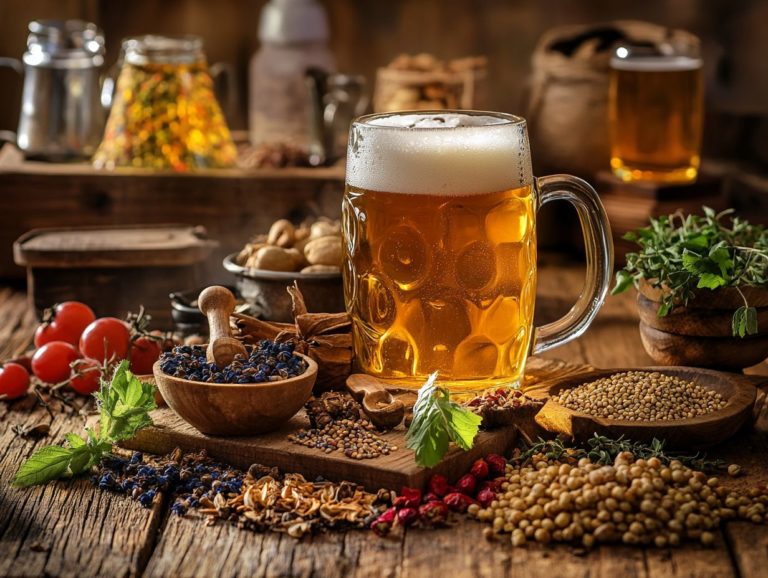Exploring the World of Spiced Beers
Spiced beers present a delightful twist on traditional brewing, infusing unique flavors that elevate your tasting experience to new heights. As the autumnal chill sets in, these beers become a quintessential fall beverage. Get ready to dive into the vibrant and exciting world of spiced beers!
With a rich history rooted in ancient brewing practices, these beers have evolved into a captivating category that includes everything from festive winter ales to seasonal pumpkin brews. This article will reveal what exactly makes a beer “spiced,” the common spices you might encounter, and how they are thoughtfully incorporated into the brewing process, including the use of pumpkin puree.
You will explore various types of spiced beers, discover ideal food pairings, and learn about potential health benefits. You will also gather insightful tips for brewing your own at home using proper brewing equipment.
Contents
Key Takeaways:
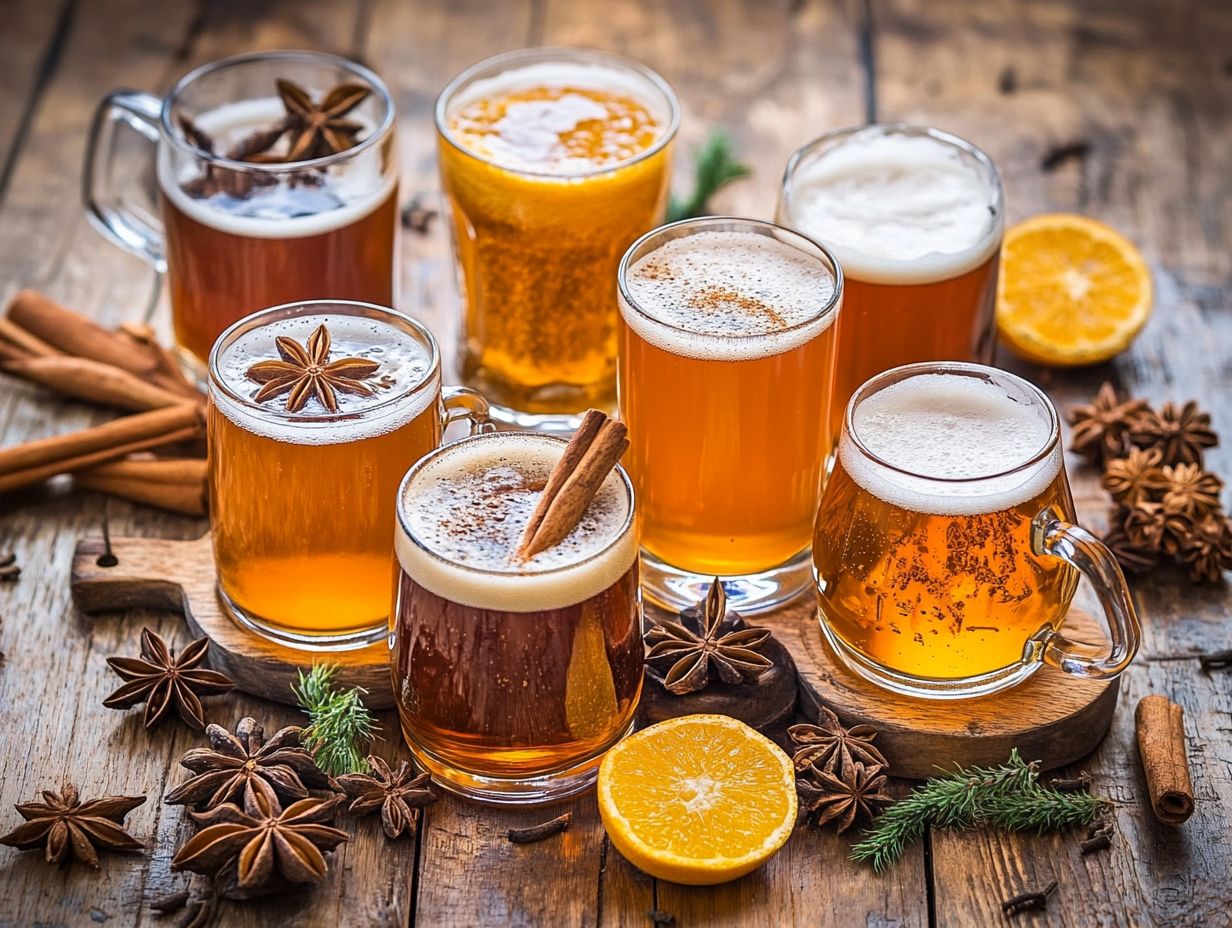
- Spiced beers are a unique and flavorful category of beer that add depth and complexity to the traditional brewing process, using an array of brewing spices.
- From ancient civilizations to modern craft breweries, the history of spiced beers spans centuries and continues to evolve.
- Common spices used in spiced beers include cinnamon, ginger, and coriander, and they can be added during the brewing process or post-fermentation to create an enhanced tasting experience.
What Are Spiced Beers?
Spiced beers present a captivating realm within the craft beer landscape, seamlessly blending a variety of traditional spices and flavors to enhance your drinking experience. As the autumn chill sets in, it s the perfect time for pumpkin spice beer to take center stage.
These brews often feature rich, inviting flavors from ingredients like cinnamon, nutmeg, and cloves. They offer you a unique experience that truly honors the artistry of brewing. With an array of styles to choose from from pumpkinhead ale, which is a lighter version, to imperial pumpkin ale, which is a stronger, richer version of traditional pumpkin ale spiced beers invite you to delve into the exciting world of seasonal beverages. Some of the best pumpkin beers like Dogfish Head Punkin Ale and Southern Tier Brewing’s Warlock highlight the creativity in this category.
History of Spiced Beers
The history of spiced beers unfolds like a rich tapestry, woven from centuries of brewing traditions and cultural practices across the globe. In the early days, various civilizations turned to brewing spices to elevate flavors and preserve their beverages.
As time went on, these distinctive creations evolved into a celebrated beer style, particularly cherished during the autumn months. They serve as a tribute to the harvest, showcasing special varieties like pumpkin spice beer and other seasonal brews that perfectly capture the essence of fall.
Origins of Spiced Beers
The origins of spiced beers can be traced back to ancient brewing traditions where local ingredients, including traditional spices and pumpkin puree, were skillfully utilized to create unique flavors. These early practices showcased the ingenuity of brewers who enhanced beer’s natural profile by adding spices like cinnamon, nutmeg, and cloves ingredients that continue to hold a prominent place in today s brewing landscape.
As cultures evolved, so did the methods and ingredients used in brewing. Regions embraced their unique resources, whether it was native herbs or fruits flourishing in their climates. This spirit of experimentation not only broadened the flavor palette of spiced beers but also strengthened community bonds by celebrating local availability.
Over time, the distinctive profiles of these brews became symbolic of their regions, transforming each sip into a narrative rich with heritage and tradition. This evolution ultimately paved the way for the diverse world of spiced beer you can enjoy today.
As you explore the many varieties of spiced beers, consider trying a local brew or participating in a brewing workshop to experience the rich flavors and creative processes behind these unique beverages!
Evolution of Spiced Beers
The evolution of spiced beers beautifully parallels advancements in brewing techniques and equipment, resulting in a diverse array of beer styles that cater to your unique tastes and preferences. As craft beer culture has surged, brewers like you have eagerly experimented with new combinations of traditional spices. They adapt recipes that not only preserve the essence of spiced beers but also introduce innovative flavors that resonate with modern palates.
This evolution shines through in popular brews such as pumpkinhead ale and good gourd, which exemplify the remarkable potential of spiced beers.
Over the years, you’ve seen the incorporation of unconventional ingredients like ginger, coriander, and exotic fruits broaden the spectrum of flavors in spiced beers. With the rise of craft breweries focusing on small-batch production, you can now discover a wide variety of unique offerings that reflect local flavors and cultural trends. This shift has given brewers the power to push boundaries, creating seasonal specials that embrace festive themes and enhance your overall drinking experience.
These innovations are often recognized and celebrated in the Beer Judge Certification Program. Such creativity not only captures the interest of adventurous drinkers like you but also celebrates the ongoing dialogue between tradition and innovation that defines the craft beer movement.
What Makes a Beer ‘Spiced’?
A beer is considered ‘spiced‘ when it incorporates an array of traditional spices, such as cinnamon, nutmeg, cloves, and allspice, during the brewing process, improving your tasting experience and offering a distinctive profile that sets it apart from standard beer styles.
The infusion of spices like cinnamon, nutmeg, cloves, and allspice creates a harmonious blend of flavors that can elevate a simple brew into a remarkable beverage especially during the fall, when options like pumpkin spice beer take center stage, providing a distinct seasonal appeal.
These flavor notes not only enhance the malt and hops the grains used to produce fermentation and the flowers used to add bitterness and aroma respectively but also stir up emotions and memories tied to the changing seasons, making it an ideal choice for autumn enthusiasts.
Common Spices Used in Spiced Beers
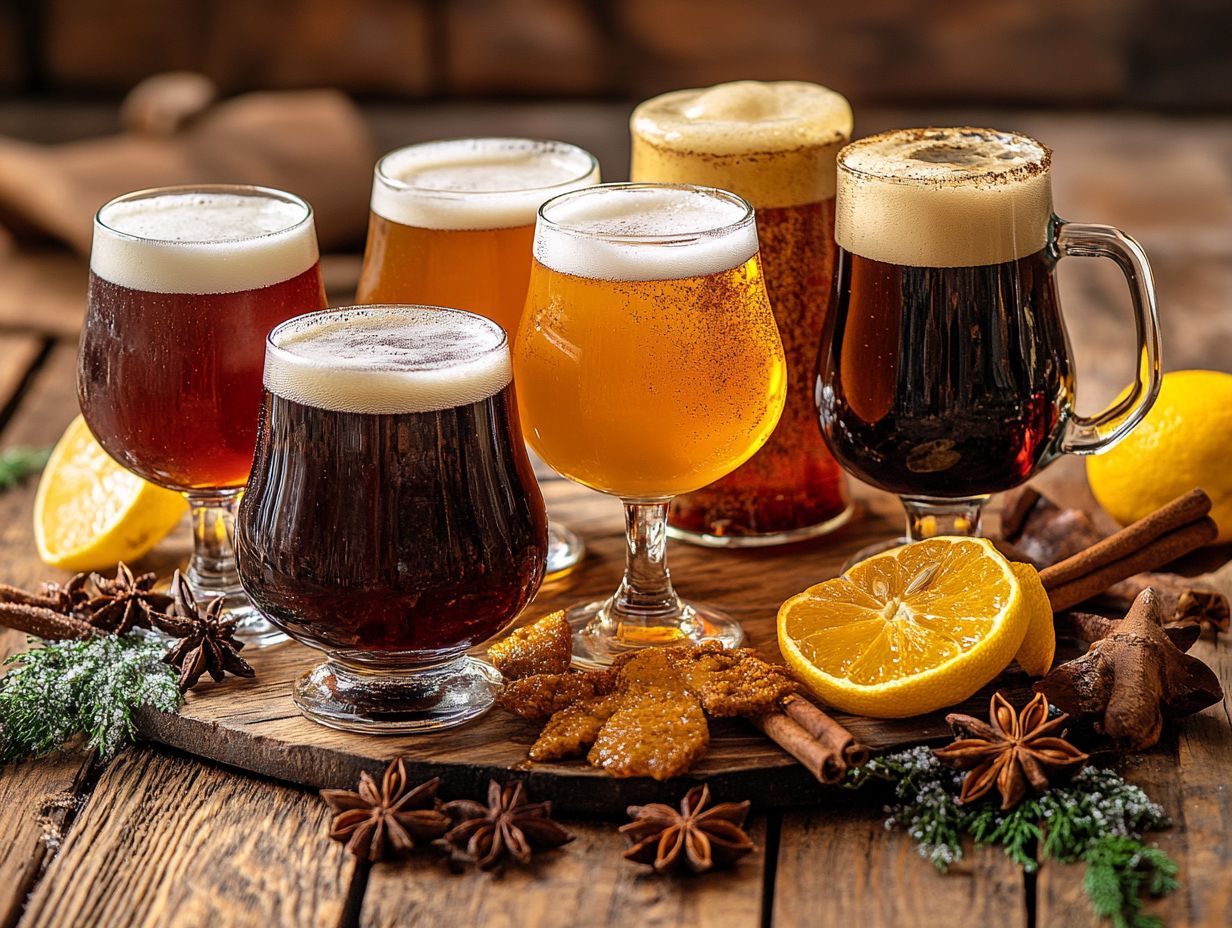
Common spices in spiced beers include staples like cinnamon, nutmeg, cloves, and allspice, each bringing its own distinct flavor profile that enhances your overall beer experience. You ll find that these spices are carefully selected for their ability to harmonize with the rich flavors of malt and hops while also evoking a warm ambiance that perfectly complements seasonal brews, especially during autumn when pumpkin spice beers reign supreme.
By incorporating these spices into the brewing process, you can create a mesmerizing array of aromas and flavors.
Cinnamon, with its sweet and woody notes, brings warmth and complexity to the table, making it an ideal companion for darker beers or those crafted with pumpkin. Nutmeg, with its slightly nutty and sweet undertones, enhances the depth of lighter ales, infusing them with a comforting familiarity, especially in winter warmers. Cloves add a spicy, aromatic kick that s frequently found in Belgian-style beers, imparting a unique layer that captivates the palate. Allspice brings together the flavors of cinnamon, nutmeg, and clove, creating a harmonious blend that can elevate any brew into a sensory delight.
These spices not only signal the change of seasons but also connect you to centuries-old traditions of spiced brewing, enriching your appreciation for the craft.
Now that you know about spiced beers, why not try brewing your own or visit a local craft brewery this fall?
How Are Spices Added to Beers?
You have the option to add spices to your beers at various stages of the brewing process. This allows you to achieve a nuanced balance of flavors that truly reflects your intended beer styles and enhances the overall experience.
Typically, you ll find that spices are introduced during the boil phase, where they infuse their essential oils into the malt and hops. They can also be added during fermentation for more subtle flavor notes. The decision of when and how to incorporate spices often hinges on the brewing equipment at your disposal and the specific outcome you desire for your final beverage.
If you’re using kettles with strainers, add spices at the beginning of the boil. This captures their aromas before transferring to the fermenters. Alternatively, you might choose to add spices after fermentation, introducing ground or whole spices during secondary fermentation. This approach allows for a more pronounced and vibrant spice character to shine through.
This method can be particularly beneficial for certain beer styles, like Belgian ales or porters, where spices such as coriander or cinnamon beautifully complement the existing flavor profiles. Timing is everything; if you add spices too late in the process, you risk muted flavors or excessive bitterness.
Ultimately, by combining the right techniques and timing along with the appropriate brewing equipment, you can create a harmonious balance of spice that significantly elevates your final product.
Types of Spiced Beers
Numerous varieties of spiced beers exist to cater to diverse palates and seasonal tastes. Each exhibits distinct characteristics that shape its flavor profile. Among these, Good Gourd and Pumpkinhead Ale stand out as exemplary autumn brews.
Many beer lovers enjoy winter spiced beers, which typically embrace warming spices to enhance the experience during the chillier months. Then there are pumpkin spiced beers, celebrated for their rich flavors and the delightful addition of pumpkin puree alongside traditional spices.
For a refreshing option, try Belgian Witbiers. They incorporate spices like coriander and orange peel, making them versatile for any occasion. Dogfish Head Punkin Ale and Southern Tier Brewing’s Warlock provide rich flavors that are perfect for the season.
1. Winter/Christmas Spiced Beers
Winter or Christmas spiced beers are a delightful celebration of the season. They are infused with warming spices like cinnamon, nutmeg, cloves, and allspice. These ingredients come together to create a comforting beverage that captures the essence of the holidays.
With a rich malt backbone to support them, the spices truly shine, evoking cherished memories of holiday gatherings and seasonal cheer. Many breweries craft unique recipes that incorporate these traditional spices, enhancing the depth of flavor and providing a memorable drinking experience.
But it s not just the spices that make these brews special; their color and aroma are equally enticing. The deep amber or dark brown hues add a visual charm that conjures images of crackling fireplaces and twinkling holiday lights.
The flavor profiles range from sweet and spicy to robust and complex, often featuring hints of caramel, toffee, and sometimes dark fruits. These characteristics make them a perfect companion to the autumnal chill and winter festivities.
As friends and families come together to celebrate, sipping on these carefully crafted beers brings the essence of winter festivities to life. Don t miss out on these seasonal brews that will elevate your holiday gatherings!
2. Pumpkin Spiced Beers
Pumpkin spiced beers have emerged as the quintessential fall beverage, celebrated for their rich flavors that artfully blend pumpkin puree with traditional spices like cinnamon and nutmeg. During the autumn season, craft brewers compete to craft the finest pumpkin beers that truly capture the essence of the harvest.
This delightful blend results in a unique drinking experience that appeals to beer enthusiasts eager to embrace the rich flavors of fall. As the leaves change and the air turns crisp, you ll want to dive into the warm, inviting embrace of these seasonal brews.
The aromas of roasted pumpkin and comforting spices can whisk you away to cozy memories of bonfire nights and festive gatherings. Notable examples include Dogfish Head’s Punkin Ale and Southern Tier Brewing’s Warlock, which have become favorites amongst craft beer aficionados. Don’t miss out on these seasonal delights!
With each sip, you experience a harmonious blend of sweetness and spice, often complemented by the hoppy notes that characterize many craft beers. This delightful concoction not only pleases the palate but also captures the spirit of autumn, making it a favored choice for harvest celebrations and gatherings with friends. Famous brews like Good Gourd and Imperial Pumpkin Ale are celebrated for their ability to encapsulate this unique experience.
3. Belgian Witbiers
Belgian Witbiers are a distinctive style of spiced beer that captures the essence of freshness and lightness. You ll notice they re often brewed with intriguing ingredients like coriander and orange peel, in addition to the usual brewing spices. These beers typically have a lovely haziness and a refreshing quality, making them perfect for warm weather or casual gatherings.
The appeal of Belgian Witbiers is recognized by the Beer Judge Certification Program, reflecting their esteemed place in the wide array of beer styles. The spices not only enhance the aroma but also elevate the overall flavor profile, offering a delightful contrast to the richer, heartier spiced beers that dominate during the colder months.
What truly sets these delicate brews apart is their beautifully balanced infusion of flavors. The zesty orange peel adds a citrusy brightness that harmonizes seamlessly with the herbal notes of coriander, creating a refreshing, slightly tart character that is both invigorating and aromatic.
Unlike darker spiced beers that often veer toward caramel sweetness or a heavier body, Belgian Witbiers maintain a light mouthfeel, making them exceptionally drinkable. The use of unmalted wheat in the brewing process contributes to their signature cloudiness and soft finish, inviting you to savor a sip while basking in the summer warmth.
Delicious Food Pairings for Spiced Beers
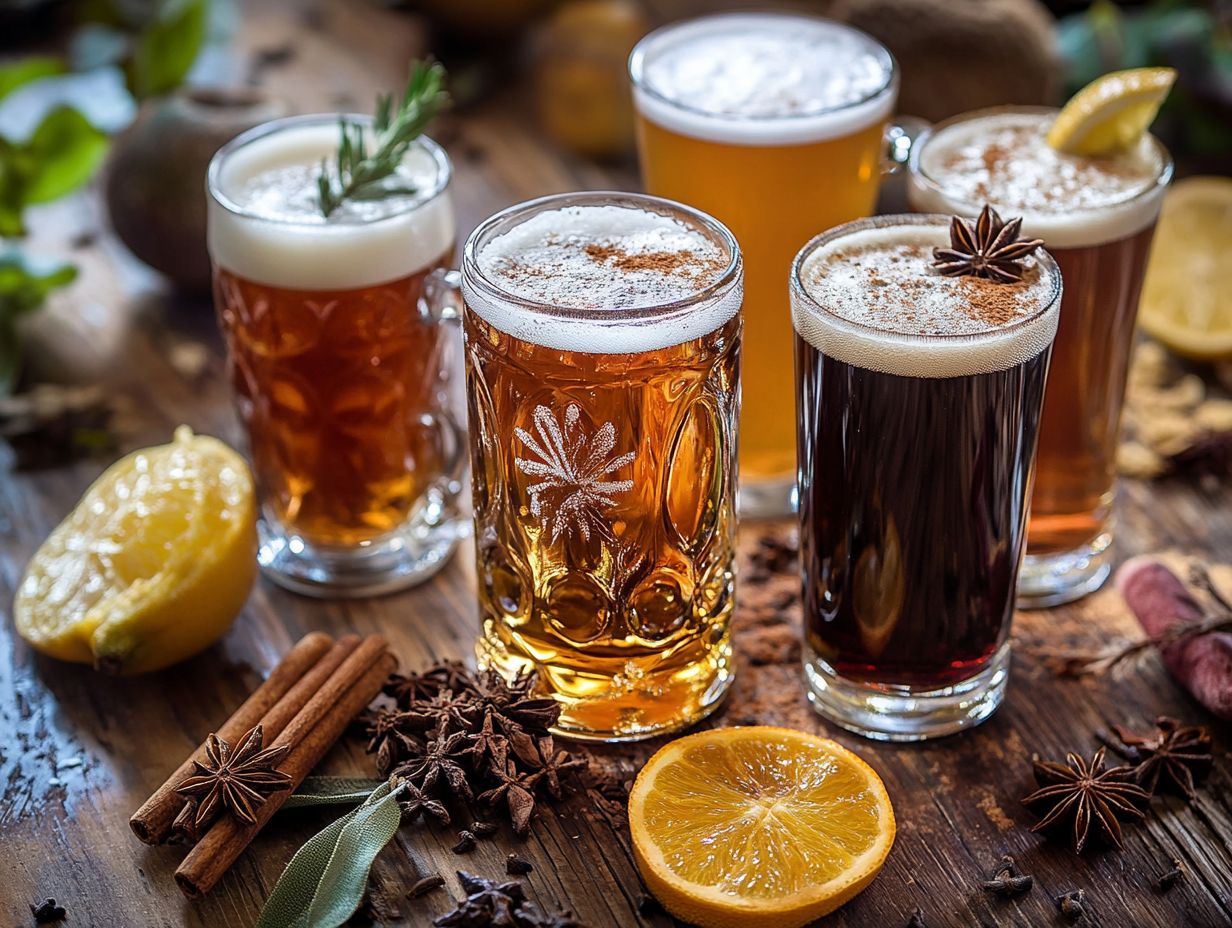
Pairing food with spiced beers can elevate the flavors of both the beverage and the meal, crafting a dining experience that truly celebrates seasonal offerings.
Consider dishes that highlight complementary spices, like roasted meats adorned with a hint of cinnamon or comforting pumpkin-based soups; these pair wonderfully with pumpkin spice beer.
On the other hand, richer winter spiced beers harmonize beautifully with hearty stews and comforting baked goods. By understanding the flavor profiles of both your food and beer, you can make selections that not only complement each other but also enhance your overall tasting experience. Consider spiced beers like Warlock, which pairs remarkably well with sweet and savory dishes.
Are Spiced Beers Healthy?
In terms of the health aspects of spiced beers, it’s crucial for you to weigh both the benefits and potential risks of enjoying these flavorful brews. On one hand, the spices commonly used in brewing, like cinnamon and nutmeg, are associated with a range of health benefits, including antioxidant properties and possible digestive support.
Making smart choices about your beer consumption can lead to a balanced approach, aligning with your wellness goals. However, moderation is essential; indulging too much in alcohol can lead to negative health consequences.
It s vital for you to make informed choices about your drinking habits to truly savor the experience while prioritizing your well-being.
Benefits of Spices in Beers
The benefits of spices in beers go well beyond mere flavor enhancement; many of these spices bring impressive health properties that can contribute to your overall wellness. Ingredients like cinnamon and nutmeg are packed with antioxidants, which help protect against cellular damage. Meanwhile, other spices are linked to anti-inflammatory and digestive advantages, adding a delightful layer to your experience with spiced beers. By understanding these benefits, you can appreciate your choices on a deeper level, enjoying an enhanced tasting experience.
Take ginger, for example. This often-included ingredient in craft brews is renowned for its ability to alleviate nausea and enhance digestion, making it a stellar addition to these beverages. Then there’s turmeric, which boasts the active compound curcumin, known for its powerful anti-inflammatory effects that support joint health and overall vitality. Cardamom provides digestive support and may even contribute cardiovascular benefits, enriching both the flavor and health profile of spiced beers. Additionally, incorporating these spices during the brewing process can amplify their benefits.
As you become more health-conscious, the blend of these spices allows you to enjoy your favorite drinks while still staying aligned with your wellness goals.
Potential Risks of Spiced Beers
While spiced beers can provide a delightful tasting experience, it’s essential for you to be aware of the potential risks that come with their consumption, particularly when it comes to alcohol intake. Overindulging can lead to a host of negative health effects, including an increased risk of addiction, liver disease, and various other complications. Therefore, enjoying spiced beers in moderation is crucial to ensure that the benefits of the spices don t get overshadowed by the inherent risks of alcohol consumption. The beer judge certification program often advises enthusiasts to understand their limits and practice mindful drinking habits.
Spiced beers often feature unique flavorings like cinnamon, ginger, or clove, which might seem innocuous at first. However, when these spices are combined with high alcohol content, it becomes easy to underestimate your overall intake, making it all too simple to overindulge. It’s vital for you to recognize that while these delightful brews can elevate social gatherings, maintaining balance is key. Responsible drinking isn t just about relishing a flavorful beverage; it also means being mindful of your health and ensuring that the enjoyment remains a positive part of the experience.
Ultimately, understanding your limits and adhering to recommended guidelines can give the power to you to savor the unique characteristics of spiced beers without dealing with unwanted side effects.
How to Brew Your Own Spiced Beer?
Brewing your own spiced beer presents an exhilarating opportunity to delve into the world of flavors, enabling you to create a distinctive beverage that reflects your unique taste preferences. This process allows you to explore various beer styles and experiment with different combinations of malt, hops, yeast, and spices.
To embark on this delightful journey, you ll need to gather the appropriate brewing equipment and cultivate a foundational understanding of the brewing process, particularly in selecting and incorporating spices with finesse. Home brewing can be a rewarding hobby that offers endless possibilities for creativity and flavor exploration.
Whether your ambition lies in crafting a classic pumpkin spice beer or a cozy winter warmer, home brewing invites you to unleash your creativity and explore the rich tapestry of the beer landscape. The brewing process allows you to tailor each batch to your specific preferences, resulting in a truly personalized beer.
1. Choosing the Right Spices
Choosing the right spices is essential for crafting a well-balanced spiced beer that truly reflects your flavor preferences and elevates your overall drinking experience. Start by considering which spices pair well with your base ingredients, like malt and hops. Think about the flavor profiles you wish to achieve do you want something warm and comforting, or perhaps bright and refreshing? Have fun experimenting with new combinations of brewing spices; this can lead to delightful discoveries and personalized recipes that capture the essence of the seasons.
Whether you prefer the subtlety of clove or the boldness of cinnamon, the right combination can make a significant difference in your final product. As you select your spices, keep in mind their strength and how they interact with the fermentation process. Some spices, like ginger and cinnamon, can deliver bold flavors that take center stage, while others may offer subtle notes that enhance the overall profile. It s wise to balance these spices according to the style of beer you re brewing, ensuring they harmonize beautifully rather than clash. Your choices can lead to a unique experience that showcases your personal touch in every bottle.
Consider when you add your spices during the brewing process, especially during the autumnal chill season, as this significantly influences the extraction of flavors, aromas, and complexity. Using traditional herbs and spices gives you endless options for fall beverages, allowing you to embark on a unique brewing adventure tailored to your individual tastes.
2. Adding Spices to the Brewing Process
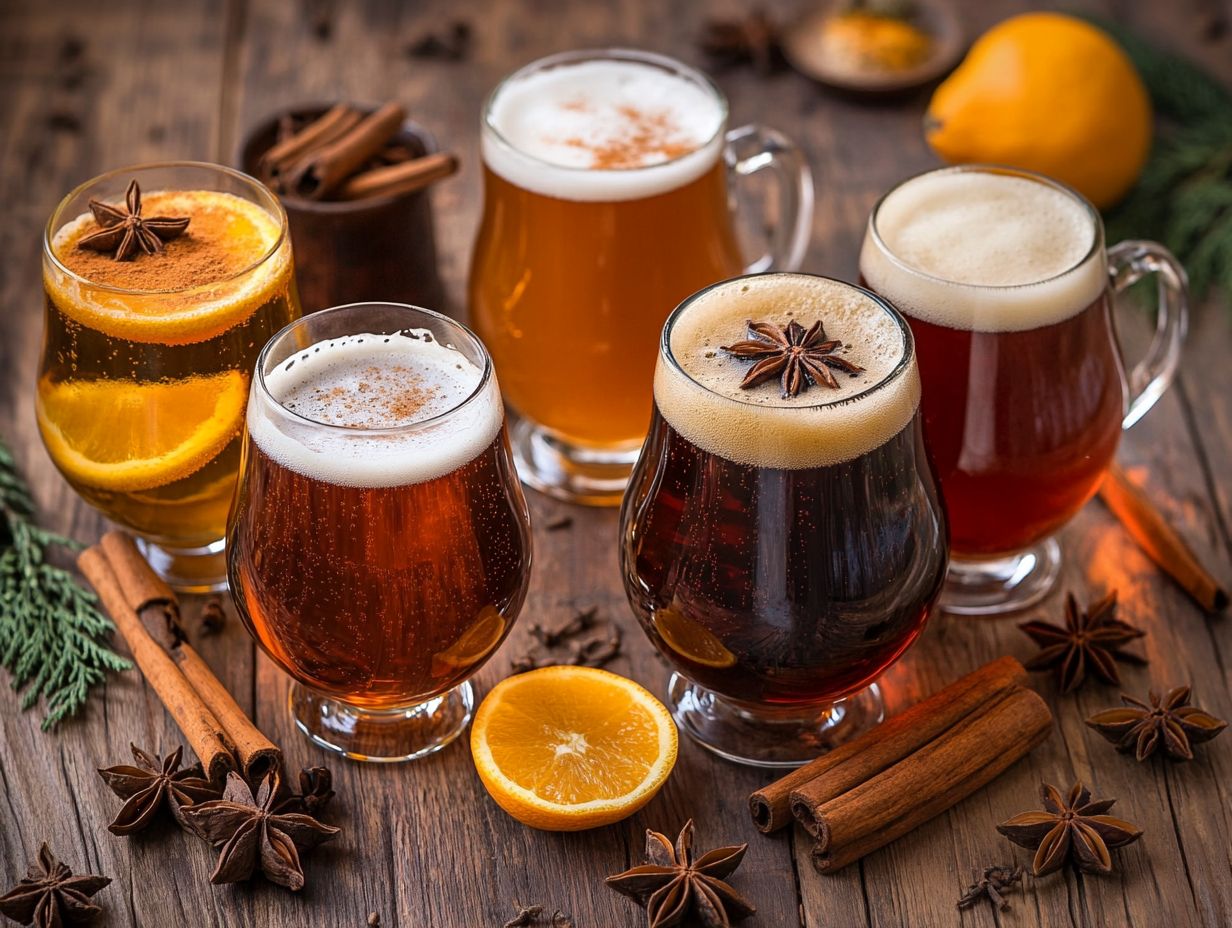
Incorporating spices and pumpkin puree into your brewing process can dramatically shape the final flavor profile with rich flavors of your spiced beer. Knowing the right moment to introduce them is crucial for crafting the best pumpkin beers. Generally, you can add spices during the boil phase to maximize the extraction of their essential oils. Alternatively, you might opt to include them during fermentation for a more delicate infusion. It’s wise to familiarize yourself with your brewing setup, as the type of equipment you use can influence how you incorporate spices, allowing you to refine your brewing process.
For instance, if you decide to add spices during the boil, the heat can amplify their aromatic qualities and traditional spices, resulting in a more robust flavor. On the other hand, introducing them during fermentation lets the subtleties of each spice shine through without overshadowing the base beer styles.
Some brewers prefer to create a spice tea, including popular preparations like Pumpkinhead Ale from Southern Tier Brewing, before adding it to the brew. This technique aids in controlling flavor intensity. Experimentation is key; the choice of spices, including Dogfish Head and Imperial Pumpkin Ale, the timing of their addition, and the method you use such as opting for whole spices versus ground will all impart unique nuances to your final product. This process allows you to craft a brew that truly reflects your individual tastes and preferences.
What spices will you experiment with in your next brew? Share your experiences below!
3. Experimenting with Different Combinations
Experimenting with a variety of brewing spices can lead you to exciting new flavors and unique recipes for spiced beers that truly stand out. By playing with different ratios and types of spices blending classic pumpkin spices with unexpected ingredients you can create unique beers that show off your personal taste and creativity.
This process hones your brewing skills and enhances your beer judge certification. It also encourages you to explore the diverse landscape of spiced beers.
The beauty of this creative journey lies in the endless possibilities that await you as you mix and match spices like cinnamon, nutmeg, and clove with more unconventional choices such as chili peppers or cardamom. To embark on this adventurous brewing experience, including unique beers like Good Gourd, Warlock, and Punkin Ale, consider starting with small test batches which allow for easy adjustments to achieve the perfect balance of flavors, adding to your enhanced tasting experience. Be sure to document your experiments and share your exciting discoveries with fellow enthusiasts; this can spark enlightening conversations and help you make informed choices about the personal twists you ve added to your brews.
Sharing your knowledge and food pairings uplifts the brewing community, inspiring others in the craft beer community to think outside the box while diminishing any fear of making mistakes along the way while exploring different brewing equipment and brewing spices.
Your Spiced Beer Questions Answered!
What exactly are spiced beers?
Spiced beers are a type of beer that is brewed with additional spices such as malt, hops, and yeast added during the brewing process. These spices can range from traditional herbs and spices like cinnamon and nutmeg to more unique ingredients like chili peppers and ginger.
What makes spiced beers unique?
Spiced beers are unique because they offer a wide range of flavors and aromas that are not typically found in traditional beers. The addition of spices can enhance the overall flavor profile and make them stand out from other types of beer.
How are spiced beers made?
Spiced beers are made by adding the desired spices to the brewing process. This can be done during the mashing stage or by adding the spices directly to the fermenter. The amount and type of spices used can vary depending on the desired flavor profile.
What spices are commonly used in spiced beers?
Some popular spices used in spiced beers include cinnamon, ginger, nutmeg, cloves, and coriander. However, many brewers also experiment with unique spices like cardamom and allspice, and even pumpkin.
Are spiced beers only available during the holiday season?
No, spiced beers are available year-round, although some breweries may choose to release specific seasonal variations. However, with the growing popularity of spiced beers, they can now be found in many craft breweries throughout the year.
What types of food pair well with spiced beers?
Spiced beers can pair well with a variety of foods, depending on the spices used. Generally, they pair well with hearty and savory dishes like roasted meats, stews, and curries. They can also be a great accompaniment to sweet desserts like apple pie or pumpkin cheesecake.

